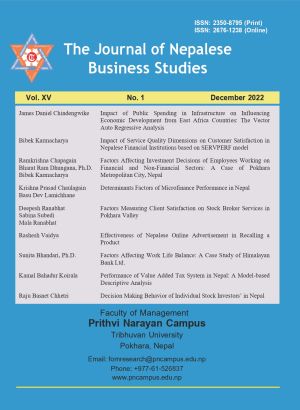Performance of Value Added Tax System in Nepal: A Model-based Descriptive Analysis
DOI:
https://doi.org/10.3126/jnbs.v15i1.50395Keywords:
GDP, non-filer, tax return, VAT, VAT gapAbstract
The implementation of Value Added Tax (VAT) policy in Nepal has completed almost 24 years. The paper intends to assess the VAT performance in terms of revenue collection over the past two decades of its implementation. An econometric modeling and descriptive analysis methods have been applied to analyze secondary time series data extracted from Economic Survey 2021. The revenue growth model is applied to calculate the ratio of change in VAT revenue in the current year over the total VAT revenue of the previous year. The data show that VAT collection has been consistently increasing and the collection gap has been decreasing over the years. The major contributing factors are burgeoning import, soaring private consumption, and newly introduced VAT withholding system.
Downloads
Downloads
Published
How to Cite
Issue
Section
License
Copyright (c) 2022 Journal of Nepalese Business Studies

This work is licensed under a Creative Commons Attribution 4.0 International License.
This license allows reusers to distribute, remix, adapt, and build upon the material in any medium or format, so long as attribution is given to the creator. The license allows for commercial use.




